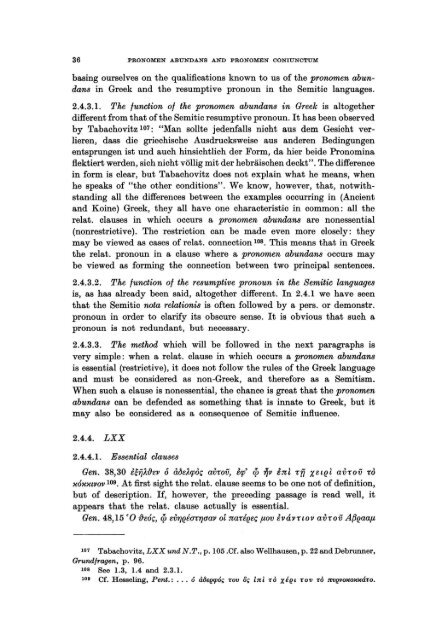Pronomen Abundans and Pronomen Coniunctum. A ... - DWC
Pronomen Abundans and Pronomen Coniunctum. A ... - DWC
Pronomen Abundans and Pronomen Coniunctum. A ... - DWC
You also want an ePaper? Increase the reach of your titles
YUMPU automatically turns print PDFs into web optimized ePapers that Google loves.
36 PRONOMEN ABUNDANS AND PRONOMEN CONIUNCTUM<br />
basing ourselves on the qualifications known to us of the pronomen abundans<br />
in Greek <strong>and</strong> the resumptive pronoun in the Semitic languages.<br />
2.4.3.1. The function of the pronomen abundans in Greek is altogether<br />
different from that of the Semitic resumptive pronoun. It has been observed<br />
by Tabachovitz 107: "Man sollte jedenfalls nicht aus dem Gesicht verlieren,<br />
dass die griechische Ausdrucksweise aus <strong>and</strong>eren Bedingungen<br />
entsprungen ist und auch hinsichtlich der Form, da hier beide Pronomina<br />
flektiert werden, sich nicht völlig mit der hebräischen deckt" . The difference<br />
in form is clear, but Tabachovitz does not explain what he means, when<br />
he speaks of "the other conditions". We know, however, that, notwithst<strong>and</strong>ing<br />
all the differences between the examples occurring in (Ancient<br />
<strong>and</strong> Koine) Greek, they all have one characteristic in common: all the<br />
relat. clauses in which occurs a pronomen abundans are nonessential<br />
(nonrestrictive). The restriction can be made even more closely: they<br />
may be viewed as cases of relat. connection 108. This means that in Greek<br />
the relat. pronoun in a clause where a pronomen abundans OCCUl'S may<br />
be viewed as forming the connection between two principal sentences.<br />
2.4.3.2. The function of the resumptive pronoun in the Semitic languages<br />
is, as has already been said, altogether different. In 2.4.1 we have seen<br />
that the Semitic nota relationis is of ten followed by a pers. or demonstr.<br />
pronoun in order to clarify its obscure sense. It is obvious that such a<br />
pronoun is not redundant, but necessary.<br />
2.4.3.3. The method which will be followed in the next paragraphs is<br />
very simpie: when arelat. clause in which occurs a pronomen abundans<br />
is essential (restrictive), it does not follow the rules of the Greek language<br />
<strong>and</strong> must be considered as non-Greek, <strong>and</strong> therefore as a Semitism.<br />
When such a clause is nonessential, the chance is great that the pronomen<br />
abundans can be defended as something that is innate to Greek, but it<br />
mayalso be considered as a consequence of Semitic influence.<br />
2.4.4. LXX<br />
2.4.4.1. Essential clauses<br />
Gen. 38,30 è~ijM}ev ó àèJeÄIPoç airrov, ÈIP' 0/ 1}v bd "Cti xeLet av"Cov "Co<br />
x6xxt'Vov 109. At fust sight the relat. clause seerns to be one not of definition,<br />
but of description. If, however, the preceding passage is read weIl, it<br />
appears that the relat. clause actually is essential.<br />
Gen. 48,15'0 {}eóç, 0/ eVrjeéa"C1JCfav ol nadeeç t-t0V Èváv"Ctov av"Cov Af3eaat-t<br />
107 Tabachovitz, LXX und N.T., p. 105 .Cf. also Wellhausen, p. 22 <strong>and</strong> Debrunner,<br />
Grundfragen, p. 96.<br />
108 See 1.3, 1.4 <strong>and</strong> 2.3.1.<br />
109 Cf. Hesseling, Pent.: ... Ó à6eecp6ç TOV öç inl Tà xieL TOV Tà nv{!Vo"o""áTO.
















